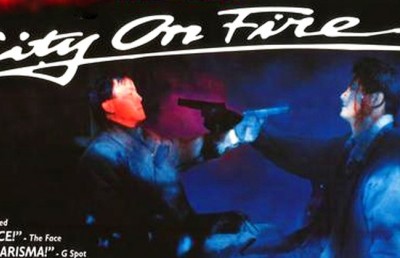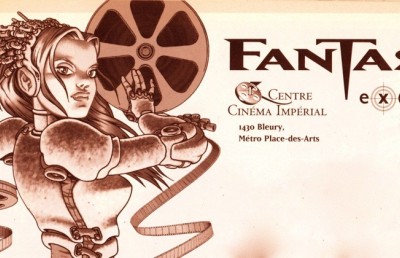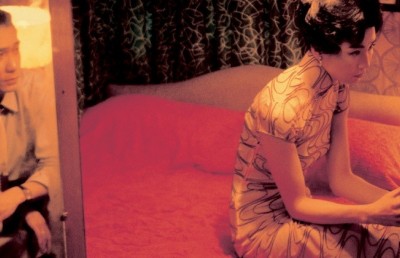The Emperor’s Naked Army Marches On: Excavating the Past
A book by Jeffrey Ruoff and Kenneth Ruoff, and a documentary by Japanese director Hara Kazuo
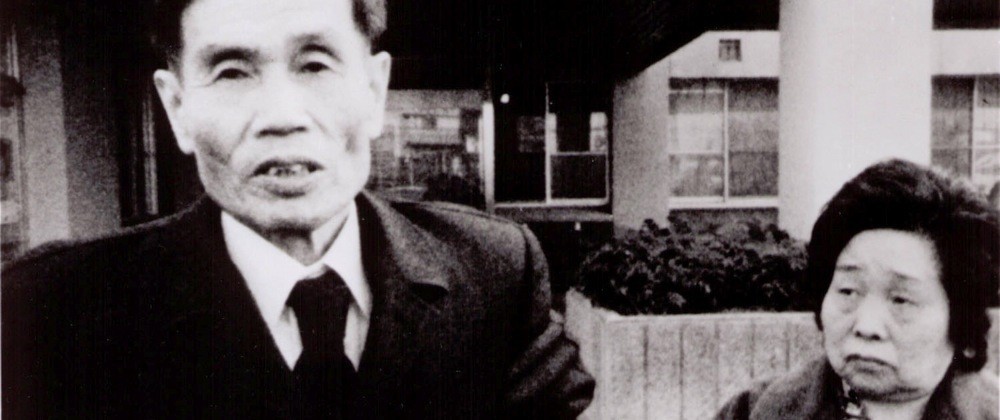
The past few years have not been kind to the image of Japan’s military history. For example, several recent books and films have raised public and media consciousness toward the atrocities perpetrated by Japanese soldiers against the city of Nanking during the Sino-Japanese War (including The Rape of Nanking: The Forgotten Holocaust of World War 2 by Iris Chang, 1997, and The Rape of Nanking by James Yin Shi Young, 1996). A recent dramatization of the same event by Chinese director Jiang Wen, Devils at the Doorstep (2000), a major hit at International film festivals, has raised a storm of controversy and is banned in China. A 1998 visit to London by the Japanese Prime Minister was continually interrupted by British war veterans turning their backs to the Prime Minister in a deviant attempt to force Japan to acknowledge its ill-treatment of allied POW’s during World War 2. Another recent book by film historian and documentarist Jeffrey Ruoff and modern Japan historian Kenneth Ruoff, entitled The Emperor’s Naked Army Marches On/Yukiyukite shingun (1998), recalls Japan’s military past by bringing to light the controversial 13 year-old documentary by Japanese director Hara Kazuo, The Emperor’s Naked Army Marches On/Yukiyukite shingun (1987).
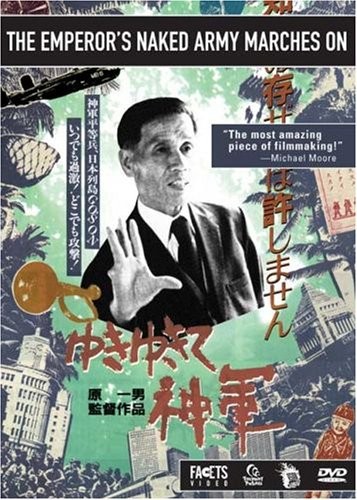
The Emperor’s Naked Army Marches On is an impassioned cinema verite-styled account of the one-man wrecking crew/dissident Okuzaki Kenzo. Okuzaki was an ex-Private of the 36th Engineering Corps who fought in the West Pacific during World War 2. Since the late 1950’s, Okuzaki took it upon himself to right the wrongs of Japan’s military past with unabashed zeal and self-ordained divinity. He has been a legendary thorn to the Establishment, tallying a long run of civic disobedience and political terrorism. In 1956 he killed a real estate broker and served 10 years in jail. He become notorious in 1969 for slinging small marbles at the Emperor in front of the Imperial Palace, for which he was for imprisoned 18 months. In 1976 he scattered pornographic handbills of the Emperor (14 months in jail). In 1981 he plotted an assassination of the ex-Prime Minister Tanaki Kanuei. And the list goes on. Okuzaki sees himself as a walking testament of political action over theory.
Hara’s film follows Okuzaki in his latest crusade: getting to the bottom of the Japanese military execution of Privates Yoshizawa and Nomura, committed 23 days after the end of World War 2. Okuzaki is dogged in his determinism, tracking down ex-Officers of the 36th Corps, and insinuating himself into their homes (with Hara’s camera of course) to conduct forceful interrogations of elderly and in some cases sick and frail men. The film hits its emotional stride, and reveals the full fury of Okuzaki’s moral zeal, during the film’s first full interrogation, of ex-Sergeant and execution squad member Takami Minoru. Takami’s behavior reflects the military Establishment’s position of concealment, secrecy, and denial. Okuzaki questions him about the garrison leader who shot his own man. Takami has no desire to confront the past, telling Okuzaki “I can’t tell you all that happened. I’m busy today.” This precipitates a shocking on-camera physical attack. Okuzaki pins him to the floor, punching and slapping him across the face, while Takami’s bewildered wife stands by calming urging, “No violence, no violence” and threatening to call the police. The attack is shocking because it is real. It recalls the real-life fight in the classic Canadian documentary Things I Cannot Change (1966), where a poor father of 11, urged to bravery by the camera’s presence, initiates a street fight with a larger man and gets beat up. The context is different, but the issue of documentary ethics is similar. We know from Okuzaki’s past that he is capable of violence. But, we wonder, is he “encouraged” by the presence of the camera to demonstrate the courage of his conviction? One thing is certain, by so bluntly showing us Okuzaki’s violent nature, Hara’s documentary paints a complex and ironic picture of Okuzaki and the Japanese psyche.
The visual style used to film this scene is also telling of Hara’s skill as a documentary filmmaker and his sensitivity to drama. When Okuzaki attacks Takami, the camera, rather than moving inward, zooms out to a further long shot position. Hara realizes how dramatic the moment is in and of itself, and does not overdo the moment by moving closer or cutting to a close-up. The shot continues uninterrupted for nearly three minutes and photographs the combatants from behind. The contrast between the highly charged emotional action and the physical distance of the camera is reminiscent of Kenji Mizoguchi’s famous one-scene, one-cut method, where he would prefer to maintain the scene’s psychological intensity at the expense of up close detail. It is clear from the film’s Rashomon-like structure, where we learn bits and pieces about the execution and from the varying vantages of different people, that Hara is very aware of narrative effect. Which is probably why the Jeffrey and Kenneth Ruoff’s book begins with the following quote from Hara: “I like to make dramatic movies. I feel strongly about this, more than other directors. I love Hollywood action films, and I wanted Okuzaki to act like an action star. I want to make action documentary films.”
The film strikes a powerful chord for many reasons. To begin with the subject matter, Okuzaki Kenzo, is fascinating. And he cuts through the traditional image of the non-confrontational, conformist Japanese. Secondly, the film takes us directly into Okuzaki’s impassioned desire for the “Truth.” The camera stares unflinchingly and without bias during Okuzaki’s progress toward truth. But, and here again we can recall Rashomon, the truth is relative. At first the executions were a result of desertion. Later we learn that they may have been a cover-up for their acts of cannibalism (of ‘white pig’, euphemism for white man). While Sakimoto Rinko, sister of victim Private Yoshizawa, believes the two lowly Privates were themselves cannibalized so that higher echelon officers could survive. But, as the authors are quick to point out, Okuzaki does not buy into any notion of relativism (p. 23). He is a moral absolutist. In any case, Okizawa reveals a hushed cover-up of military atrocity, desertion of the Imperial Army, and fraternal abuse during the Japanese occupation of New Guinea.
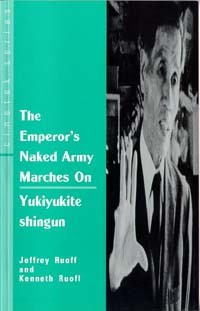
The book begins by setting up Hara, a product of the politicized 1960’s and 1970’s, as an outlaw who has always shared an empathy with the wayward drifters and radicals who form the subjects of his documentary films (outside of Okuzaki, a disabled poet, a radical feminist, and the left-wing essayist Inoue Mitsuharu). The authors demonstrate that Hara was no stranger to the ethical issues formed in Naked. In his first film, Sayonara CP (1972), Hara renders a stark image of physical disability, to the point where the protagonist’s wife disputes Hara’s controversial representation of disabled poet Yokota Hiroshi within the film. But this strategy is part and parcel of Hara’s reflexive documentary cinema. As the authors learned through interviews with Hara, Hara is not interested in simply recording reality with an impassive camera, but in taking an active part in the event. Thus situating Hara within the tradition of the French cinema verite (Jean Rouch, the French Unit of the NFB) rather than the English direct cinema (Unit B of the NFB, Candid Eye, Maysles brothers, Wiseman, Pennebaker, etc.)
After the biographical introduction, the book sets up both the film’s broad and specific historical context, beginning with Japan’s initial military involvement with Manchuria in 1931 and the Sino-Japanese war of 1937, and Japan’s eventual fall from victory to shattering defeat. At the more local level, we learn that Okuzaki was among the 30 survivors of the more than 1000 members of the 36th Engineering Corps. Along with Okuzaki, 10 other survivors appear in Naked, which makes Naked an important testimony to a moment in Japanese military history when moral was low and hope of winning vanquished. Once defeat was imminent the Emperor made the vaulted decision to exit the war to “save” more people from dying. Blame for defeat trickled from the Emperor, to the people, to the militarists. To save face and instill the myth of Japan as a peaceful nation at heart, there was a political decision, initiated during the Allied Occupation, to absolve the Emperor of any war responsibility. For a viewer of the film, this historical context provided by the authors cleverly sets up the encounters we witness in the film, where the interrogated people deflect the blame onto others. A fact that particularly angers Okuzaki. When an officer repeats the classic wartime justification, “An order is an order, we had to obey,” Okuzaki beats the veteran to the ground. And Okuzaki is not afraid to return the blame to the Emperor, flatly stating in the film that “the Emperor is a symbol of ignorance and irresponsibility.” Though the film was extremely controversial, a fact that put director Hara firmly in the arthouse/film festival circuit, the authors also point out that during the period of the film’s making Japan’s Prime Minister was Nakasone Yasuhiro, a veteran of the Pacific War and the first post-war Prime Minister to raise the issue of the Emperor’s moral responsibility for the war. Hence even given the film’s radical subject, the political climate for such an inquisition, while not “ripe”, was at least amenable to its possibility.
The book follows the historical context with a detailed account of the film’s production history. We learn that Okuzaki had initially approached the more established director Imamura Shohei to make a film on his life, but Imamura declined and suggested his camera assistant Hara Kuzuo. The film was produced independently through Hara and his wife Kobayashi Sachiko’s company Shisso Productions. It was partly financed by Imamura and Okuzaki himself, and completed over a five-year period (1982-1987) for a total budget of $250,000. According to Hara, the film’s structure only formed during the process of research and shooting. Initially it was meant to be a general portrait of the war generation, but shifted to the executions after Hara came across documented proof of the incident, and after the filming of the ex-Sergeant Takami Minoru. While watching the film one senses that Okuzaki, though noble in intention, is a troubled, volatile, and unpredictable man. It is a portrait that adds irony and complexity to Okuzaki’s driven moral purgation: while Okuzaki has ordained himself as moral judge and executor of Japan’s past, he is very clearly a product of that past. Therefore I was not surprised to read the following Hara quote about Okuzaki in the book: “Some of the younger staff members quit. I, too, really came to dislike Okuzaki. He was chaotic. In the film he sounds logical only because of skillful editing. The way he speaks is often incoherent” (15). The extent of Okuzaki’s vindictiveness and instability is further confirmed in the book when we learn that Okuzaki had told Hara of his plan to murder one of his former officers, and had asked Hara to film the murder. Hara decided against it after discussing it with his wife and Imamura (just the fact that Hara even considered agreeing with Okuzaki is, to this reader, equally disturbing!). The book discloses other fascinating bits of information concerning the “Okuzakian” trials and tribulations director Hara faced during the filming.
The authors then move on to a detailed character and narrative analysis. They take Hara’s quoted intention of making Okuzaki an “action hero” and include it as part of their character analysis. On many occasions in the film Okuzaki reiterates how he is not concerned about conventional law, but answers to God’s law. This divine inspiration allows Okuzaki to act upon his base instincts of justice. In this light, the authors liken Okuzaki to the classic film noir anti-hero that acts above the law and conforms to his own notion of right and wrong (one could add the classic Western gunslinger here as well). Though they also add that the unconventional nature of his interrogations, the odd intermittent police presence, and Okuzaki’s own shifting from complete observance of Japanese social decorum to ludicrous bouts of anti-social behavior make Okuzaki somewhat of a comic anti-hero as well (like the scene where Okuzaki acts as a go-between in a marriage and begins his speech in a befitting fashion but then veers off into an anti-Establishment tirade that condemns the very institute he has been asked to uphold, the family [p. 28]). However, the authors argue that what makes this documentary different from most is its non-judgmental position toward both its subject matter and the issues raised. Whereas Okuzaki is an eccentric, marginalized person in Japan, the very existence of the documentary gives him a voice that forces the viewer to pass judgement themselves between the uncomfortable feeling of voyeurism manifested in the film and its important social content. The book concludes with a discussion of the film’s volatile critical reception in Japan upon its release in 1987. Though deemed too controversial to be picked up by any of the major Japanese studios, the film did play in arthouse theatres across many major Japanese cities, was released on video, and enjoyed a successful commercial run for a non-fiction film (estimates of one million theatre viewers, though as yet no screening on national television).
In articulating its place in Japanese social history, the authors compare its impact to that of Marcel Ophül’s 1971 The Sorrow and the Pity on the French acceptance of their complicity with the Nazis during the Vichy era. Likewise, Naked was controversial precisely because it departed from the established notion of Japan as “victims” in the World War 2, to an acknowledgement of its role as military aggressor. The authors see the film as part of the social and cultural complex that is necessary in shifting the Japanese “victim’s consciousness” to a consciousness that is willing to come to terms with the atrocities and aggressions of its military past. [Released in the same year as Naked was the Chinese exploitation, docu-drama Man Behind the Sun, which dealt with the infamous Japanese wartime experimental unit, Camp 731. For an interview with its director, (T.F. Mous: The Man Behind the Sun).].
The Flick Book “Cinetek” series (which presently stands at 26 volumes) is similar in scope to the BFI’s “Film Classics” and “Modern Classics” series. Each slim volume deals with a singular film by providing the necessary historical and critical context and textual analysis. Where the “Cinetek” series differs is in its decision to feature lesser known, unconventional, and in some cases, controversial films (for example, The Asthenic Syndrome, Chance of a Lifetime, Jew Süss, Sunless, Song of the Exile, and Poison). Given the inherent limits of its design (only 57 pages), this book succeeds admirably in providing the right balance between critical and historical context, interpretative insight, and textual analysis. Though the authors rightly place the film’s social and political meanings at the book’s center, they also acknowledge its relationship to the documentary tradition (ethical issues, responsibility of filmmaker to their subjects, relationship between fact and fiction, documentary and narrative, etc.). Kudos, then, to Flick Books and authors Jeffrey Ruoff and Kenneth Ruoff for bringing into the spotlight such an invigorating and challenging piece of documentary filmmaking.
Review copy of the book provided by Jeffrey Ruoff.




